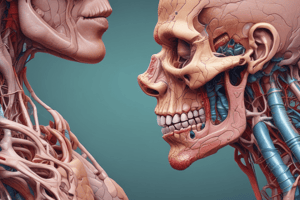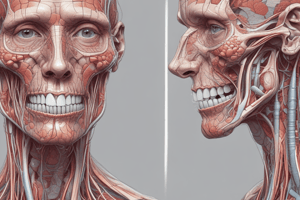Podcast
Questions and Answers
What are the two curvatures of the stomach, and how do they differ?
What are the two curvatures of the stomach, and how do they differ?
The lesser curvature is the upper right surface of the stomach, while the greater curvature is the lower left surface.
How does the stomach's size change after a meal?
How does the stomach's size change after a meal?
After a meal, the stomach enlarges due to the distention of its walls; it can hold about 1 to 1.5 liters of volume.
Where is the stomach located within the abdominal cavity?
Where is the stomach located within the abdominal cavity?
The stomach lies in the upper part of the abdominal cavity, under the liver and diaphragm.
What role do sphincter muscles play at the openings of the stomach?
What role do sphincter muscles play at the openings of the stomach?
What happens to the walls of the stomach after food passes out?
What happens to the walls of the stomach after food passes out?
What are rugae, and what is their significance in the stomach?
What are rugae, and what is their significance in the stomach?
What factors can influence the size of the stomach?
What factors can influence the size of the stomach?
Describe the shape of the stomach in relation to its contents.
Describe the shape of the stomach in relation to its contents.
What is the primary function of the pylorus in the digestive system?
What is the primary function of the pylorus in the digestive system?
How do the muscle layers (longitudinal, circular, and oblique) contribute to gastric motility?
How do the muscle layers (longitudinal, circular, and oblique) contribute to gastric motility?
Describe the role of the lower esophageal sphincter (LES) in preventing acid reflux.
Describe the role of the lower esophageal sphincter (LES) in preventing acid reflux.
What is the significance of rugae in the stomach's design?
What is the significance of rugae in the stomach's design?
Identify the primary components of the gastric mucosa and their functions.
Identify the primary components of the gastric mucosa and their functions.
Explain the importance of the serosa in the structure of the stomach.
Explain the importance of the serosa in the structure of the stomach.
What differentiates the fundus from the body of the stomach in terms of function?
What differentiates the fundus from the body of the stomach in terms of function?
How does the pyloric sphincter control the flow of chyme into the duodenum?
How does the pyloric sphincter control the flow of chyme into the duodenum?
What type of epithelium is found in the mucosa of the esophagus, and what is its primary function?
What type of epithelium is found in the mucosa of the esophagus, and what is its primary function?
Describe the muscle layer composition of the stomach and its unique features compared to other organs in the digestive tract.
Describe the muscle layer composition of the stomach and its unique features compared to other organs in the digestive tract.
What structural feature allows the small intestine to maximize nutrient absorption?
What structural feature allows the small intestine to maximize nutrient absorption?
Identify the tissue modification found in the large intestine that contributes to its unique appearance.
Identify the tissue modification found in the large intestine that contributes to its unique appearance.
What role do the lymphoid nodules play in the small intestine?
What role do the lymphoid nodules play in the small intestine?
Explain the significance of the rugae present in the stomach mucosa.
Explain the significance of the rugae present in the stomach mucosa.
What is the composition and function of the serosa surrounding the stomach?
What is the composition and function of the serosa surrounding the stomach?
How do anal columns contribute to the anatomy of the large intestine?
How do anal columns contribute to the anatomy of the large intestine?
What modifications of the mucosa are present in the esophagus to facilitate its function?
What modifications of the mucosa are present in the esophagus to facilitate its function?
Describe the role of Brunner's glands in the small intestine.
Describe the role of Brunner's glands in the small intestine.
What is the anatomical significance of the cricoid cartilage in relation to the esophagus and the airway?
What is the anatomical significance of the cricoid cartilage in relation to the esophagus and the airway?
Describe the function of the upper esophageal sphincter (UES).
Describe the function of the upper esophageal sphincter (UES).
What role does the cricopharyngeus muscle play in the function of the esophagus?
What role does the cricopharyngeus muscle play in the function of the esophagus?
Explain the significance of the esophageal hiatus.
Explain the significance of the esophageal hiatus.
What structure is located superior to the cervical part of the esophagus?
What structure is located superior to the cervical part of the esophagus?
How do the lower esophageal sphincter (LES) and the diaphragm interact?
How do the lower esophageal sphincter (LES) and the diaphragm interact?
Identify the location where the esophagus transitions from the thoracic part to the abdominal part.
Identify the location where the esophagus transitions from the thoracic part to the abdominal part.
What is the anatomical relationship between the aortic arch and the thoracic part of the esophagus?
What is the anatomical relationship between the aortic arch and the thoracic part of the esophagus?
What muscle assists in the functioning of the thoracic part of the esophagus?
What muscle assists in the functioning of the thoracic part of the esophagus?
Discuss the potential implications of dysfunction in the lower esophageal sphincter.
Discuss the potential implications of dysfunction in the lower esophageal sphincter.
What percentage of total salivary volume is contributed by the minor salivary glands?
What percentage of total salivary volume is contributed by the minor salivary glands?
Where are the parotid glands located in relation to the masseter muscle?
Where are the parotid glands located in relation to the masseter muscle?
How much saliva do the major salivary glands produce daily?
How much saliva do the major salivary glands produce daily?
What is the primary function of buccal gland secretion?
What is the primary function of buccal gland secretion?
What type of gland is classified as a major salivary gland?
What type of gland is classified as a major salivary gland?
What anatomical structures are found within the pulp cavity associated with teeth?
What anatomical structures are found within the pulp cavity associated with teeth?
What structure is referred to as the gum surrounding the teeth?
What structure is referred to as the gum surrounding the teeth?
What is the role of the periodontal ligament?
What is the role of the periodontal ligament?
Flashcards are hidden until you start studying
Study Notes
Salivary Glands
- Major salivary glands include the parotid, submandibular, and sublingual, producing approximately 1 liter of saliva daily.
- Minor salivary glands, or buccal glands, contribute less than 5% of saliva but are important for oral hygiene.
- Parotid glands are the largest, located between the skin and masseter muscle, anterior to the external ear.
Stomach Anatomy
- The stomach is located under the liver and diaphragm, typically holding 1 to 1.5 liters in adults.
- It has two curvatures: the lesser curvature (upper right surface) and greater curvature (lower left surface).
- The stomach can enlarge significantly after meals but shrinks as food is digested.
Sphincter Muscles
- Sphincter muscles control the passage of materials into and out of the stomach.
- Two important sphincters are the lower esophageal sphincter (at the entrance of the stomach) and pyloric sphincter (at the exit).
Structural Modifications
- The stomach's mucosa features folds called rugae, enhancing distention and digestion.
- The muscularis layer has three muscle layers: circular, longitudinal, and oblique, providing greater control over food movement.
- The serosal layer consists of visceral peritoneum forming the greater and lesser omentum, which connects the stomach to nearby organs.
Digestive Tract Wall Modifications
- Esophagus: Stratified squamous epithelium for abrasion resistance; muscularis includes striated muscle in the upper part and smooth muscle in the lower part.
- Small intestine: Contains permanent circular folds (plicae circulares) and finger-like projections (villi) for nutrient absorption.
- Large intestine: Characterized by three tapelike strips (taeniae coli) and sac-like structures (haustra), aiding in the compaction of waste.
Nerve and Vascular Supply
- The pulp cavity within teeth contains nerves and vessels, crucial for dental health and sensitivity.
- The gingiva (gum) serves as protective tissue surrounding teeth, also vital for oral hygiene.
Sensory and Structural Features
- The upper lip features a philtrum, a sensitive area prone to irritation due to its location between skin and mucous membrane.
Studying That Suits You
Use AI to generate personalized quizzes and flashcards to suit your learning preferences.




